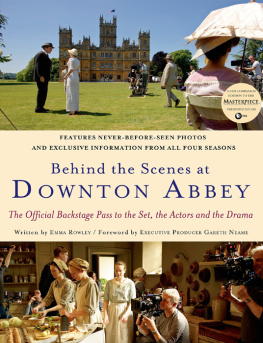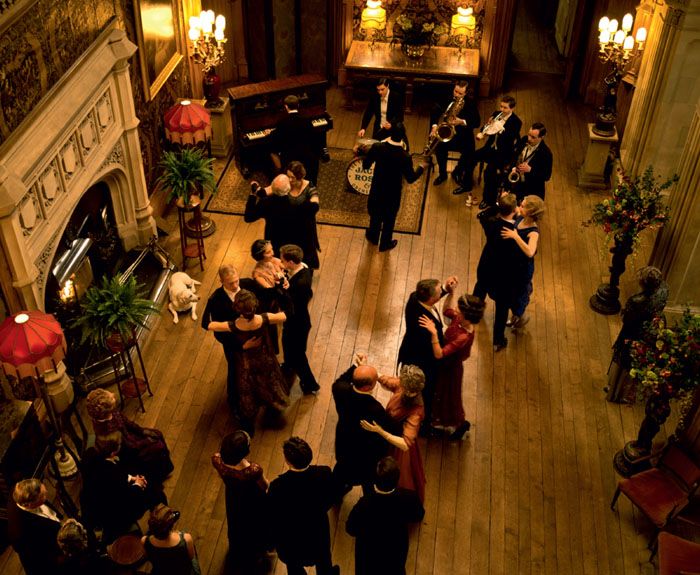The author and publisher have provided this e-book to you for your personal use only. You may not make this e-book publicly available in any way. Copyright infringement is against the law. If you believe the copy of this e-book you are reading infringes on the authors copyright, please notify the publisher at: us.macmillanusa.com/piracy.
FOREWORD
Gareth Neame
It was an inauspicious start. As I alighted from my cab outside Drones restaurant in Belgravia (a suitably traditional venue in which to have a working dinner with Julian Fellowes), there he was, hanging about outside, saying, we cant eat here, their gas is off. So began a meandering journey through a London neighbourhood that I suppose the Crawleys might have known well although of course they were not invented until later that evening. Eventually we found our haven and over a touristic Italian supper I proposed an idea to Julian that became Downton Abbey.
I had seen Gosford Park, the movie that Julian had written so beautifully. I had been incredibly impressed by it. It was not so much the over-arching whodunnit element but just the simple depiction of its world that captured me.
I had long thought that the setting of an English country house during the Edwardian era would make a very suitable arena for an episodic television series. I have often been drawn to cinema for ideas, adjusting and fine-tuning them for television, where in place of the one-off spectacle of the silver screen you have a much larger canvas on which to paint all the characters. Television also offers the joy of repeated pleasure because your audience is able to connect with the characters on a weekly basis. Naturally, some years earlier I had seen Gosford Park, the movie that Julian had written so beautifully for the late Robert Altman. I had been incredibly impressed by it. It was not so much the over-arching whodunnit element but just the simple depiction of its world that captured me. Having worked in British TV drama for a quarter of a century, I was very familiar with maids, footmen and aristocrats, Britains extraordinary inventory of historic houses and also our literary inspiration for drama. But when I watched Gosford Park it struck me how I had never entirely believed in the realisation of the setting in its many previous iterations. For once, I felt comfortable in the hands of the filmmakers and I truly appreciated what a fascinating environment I was being transported into. The film stayed in my imagination.

Over dinner Julian and I talked about the DNA of the show agreeing that it should be equally weighted between the family and its servants. It would have the traditional setting of the Edwardian country house but the density of stories and pace of narrative that is more familiar in a contemporary series. We wanted the show to be something that felt tangible and relevant, so that the audience didnt so much look back nostalgically but could imagine what it would be like to be, say, Mary changing her attire half a dozen times a day to suit the next leisure activity, or Daisy making two dozen fires before dawn. We selected the years just prior to the First World War as the apogee of the country house and indeed the supremacy of the aristocracy, as much because of the similarities between these characters and ourselves as for the differences. Although their display of rather precise behaviour and manners marks them out as different from us, they have motor cars and electricity, hopes, dreams and ambitions, and are as befuddled by the technology of their age as we are by our latest gadgets from Apple.
Despite our excited and animated conversation about the idea, Julian was initially cautious to revisit the ground he had covered so successfully before (he had, after all, won the Academy Award for his Gosford Park screenplay), I think on the grounds that lightning doesnt strike twice in the same place. However, some days later I received an email, which over no more than a couple of pages described his initial thoughts on all the major characters who would come to inhabit Downton. The inheritance issue, the lack of a suitable male heir, the distant cousin entering their world for the first time were all there from the off. I had a strong sense that Julian had lived with these characters for many years but was only now describing them on the page. At once the world came alive for me.
Julian and I took the project to Laura Mackie and Sally Haynes at ITV, and with their enthusiastic backing I commissioned Julian to write the first episode. I never forget that his opening stage direction set the premise for Downton Abbey in the most economic, but tantalising, way: The sun is rising behind Downton Abbey, a great and splendid house in a great and splendid park. So secure does it appear, that it seems as if the way of life it represents will last for another thousand years. It wont. The script was a page-turner and, despite 2009 being a low point as the recession hit the TV industry, Laura and her boss Peter Fincham were so convinced by the material that they ordered the series for production.
Making the first series was a lesson in attention to detail, as we sought to re-enact the style and etiquette of another age and bring to the show the best possible production values that we could. It all went so seamlessly that I became convinced that it was too easy and enjoyable and that the result might end up being a disappointment! After all, so many creative successes have to endure torturous journeys and difficult births. Julian and I had now been joined on the project by our key collaborators, the architects of Downton Abbey our producing partners Liz Trubridge and Nigel Marchant, lead director Brian Percival, casting director Jill Trevellick, production designer Donal Woods and costume designer Susannah Buxton.
Alongside Julians exquisite scripts was the finest cast of British acting talent we could have assembled. What was so satisfying about it was how Jill appeared to have effortlessly combined much-loved and respected actors such as Dame Maggie Smith, Penelope Wilton, Hugh Bonneville and Jim Carter, with those at the very start of their careers, such as Laura Carmichael and Sophie McShera.
The launch of the show on ITV in September 2010 was a resounding hit and its success was galvanised by a rare spike in ratings for the second episode (very unusually suggesting that all those who sampled the first episode not only came back for more but also brought their friends). Within days of the shows debut,















